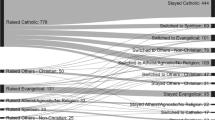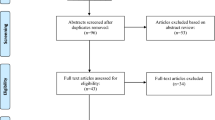Abstract
To evaluate the relationship between spiritual experience and hysterical experiences in Buddhist participants in ethnic groups in China, this cross-sectional study recruited 39 participants aged 16–57 years old, and self-administered surveys were administered in two villages, one city and one town by four research assistants in the Inner Mongolia and Qinhai areas. Binary logistic regression analyses were used to evaluate the factors associated with somatoform dissociation symptoms. Surveys were completed by 639 participants (mean age 31 years; 54.6% females) in 2017. Binary regression models showed that diverging from tradition and having a college education or above were associated with suffering from somatoform dissociation symptoms. By contrast, participants with higher experiences and older people were less likely to experience somatoform dissociation symptoms. Our current research highlights the contribution of spiritual experiences and traditional values to reducing somatization dissociation symptoms, and the findings could help to promote a new relationship between psychiatry and spiritual experiences that will benefit both mental health professionals and those who seek their assistance.
Similar content being viewed by others

References
Abarghouei, M., Sorbi, M. H., Abarghouei, M. R., & Bidaki, R. (2016). The relationship between religious coping strategies and happiness with meaning in life in blind people. Global Journal of Health Science, 9(1), 57954. https://doi.org/10.5539/gjhs.v9n1p130.
Aflakseir, A., & Mahdiyar, M. (2016). The role of religious coping strategies in predicting depression among a sample of women with fertility problems in Shiraz. Journal of Reproduction & Infertility, 17(2), 117–122.
Ahmad, F., Muhammad, M., & Abdullah, A. A. (2011). Religion and spirituality in coping with advanced breast cancer: Perspectives from Malaysian Muslim women. Journal of Religion and Health, 50(1), 36–45. https://doi.org/10.1007/s10943-010-9401-4.
Akyuz, G., Dogan, O., Sar, V., Yargic, L. I., & Tutkun, H. (1999). Frequency of dissociative identity disorder in the general population in Turkey. Comprehensive Psychiatry, 40(2), 151–159.
Ali, S., Jabeen, S., Pate, R. J., Shahid, M., Chinala, S., Nathani, M., et al. (2015). Conversion disorder-mind versus body: A review. Innovations in Clinical Neuroscience, 12(5–6), 27.
Amaral do Espirito, H. M., & Pio-Abreu, J. L. (2007). Dissociative disorders and other psychopathological groups: Exploring the differences through the Somatoform Dissociation Questionnaire (SDQ-20). Revista Brasileira de Psiquiatria, 29(4), 354–358.
American Psychiatric Association. (2013). Diagnostic and statistical manual of mental disorders (DSM-5®). American Psychiatric Pub.
Anye, E. T., Gallien, T. L., Bian, H., & Moulton, M. (2013). The relationship between spiritual well-being and health-related quality of life in college students. Journal of American College Health, 61(7), 414–421. https://doi.org/10.1080/07448481.2013.824454.
Bohlmeijer, E., Prenger, R., Taal, E., & Cuijpers, P. (2010). The effects of mindfulness-based stress reduction therapy on mental health of adults with a chronic medical disease: A meta-analysis. Clinical Psychology Review, 68(6), 539–544. https://doi.org/10.1016/j.jpsychores.2009.10.005.
Boss, L. P. (1997). Epidemic hysteria: A review of the published literature. Epidemiologic Reviews, 19(2), 233–243.
Burton, R. (2003). Spiritual pain: A brief overview and an initial response within the Christian tradition. Journal of Pastoral Care & Counseling, 57(4), 437–446. https://doi.org/10.1177/154230500305700408.
Carmody, J., Reed, G., Kristeller, J., & Merriam, P. (2008). Mindfulness, spirituality, and health-related symptoms. Journal of Psychosomatic Research, 64(4), 393–403. https://doi.org/10.1016/j.jpsychores.2007.06.015.
Chen, H., Cheal, K., McDonel Herr, E. C., Zubritsky, C., & Levkoff, S. E. (2007). Religious participation as a predictor of mental health status and treatment outcomes in older persons. International Journal of Geriatric Psychiatry, 22(2), 144–153. https://doi.org/10.1002/gps.1704.
Chen, Z., Qi, W., Hood, R. W., & Watson, P. J. (2011). Common core thesis and qualitative and quantitative analysis of mysticism in Chinese Buddhist Monks and Nuns. Journal for the Scientific Study of Religion, 50(4), 654–670.
Chen, Z., & Watson, P. J. (2011). Mystical experience among Tibetan Buddhists: The common core thesis revisited. Journal for the Scientific Study of Religion, 50(2), 328–338.
Chen, C. S., Yen, C. F., Lin, H. F., & Yang, P. (2003). Mass hysteria and perceptions of the supernatural among adolescent girl students in Taiwan. The Journal of Nervous and Mental Disease, 191(2), 122–123. https://doi.org/10.1097/01.NMD.0000050941.22170.A5.
Chen, Z., Zhang, Y., Hood, R. W., & Watson, P. (2012). Mysticism in Chinese Christians and non-Christians: Measurement invariance of the Mysticism scale and implications for the mean differences. International Journal for the Psychology of Religion, 22(2), 155–168.
Conner, N. E., & Eller, L. S. (2004). Spiritual perspectives, needs and nursing interventions of Christian African-Americans. Journal of Advanced Nursing, 46(6), 624–632. https://doi.org/10.1111/j.1365-2648.2004.03053.x.
Cotton, S., Zebracki, K., Rosenthal, S. L., Tsevat, J., & Drotar, D. (2006). Religion/spirituality and adolescent health outcomes: A review. Journal of Adolescent Health, 38(4), 472–480. https://doi.org/10.1016/j.jadohealth.2005.10.005.
Crandell, D. L., & Dohrenwend, B. P. (1967). Some relations among psychiatric symptoms, organic illness, and social class. American Journal of Psychiatry, 123(12), 1527–1538. https://doi.org/10.1176/ajp.123.12.1527.
Cruz, J. P., Colet, P. C., Alquwez, N., Inocian, E. P., Al-Otaibi, R. S., & Islam, S. M. (2017). Influence of religiosity and spiritual coping on health-related quality of life in Saudi haemodialysis patients. Hemodialysis International, 21(1), 125–132. https://doi.org/10.1111/hdi.12441.
De Bustos, E. M., Galli, S., Haffen, E., & Moulin, T. (2014). Clinical manifestations of hysteria: An epistemological perspective or how historical dynamics illuminate current practice. Frontiers of Neurology and Neuroscience, 35, 28–43.
de Frias, C. M., & Whyne, E. (2015). Stress on health-related quality of life in older adults: The protective nature of mindfulness. Aging & Mental Health, 19(3), 201–206. https://doi.org/10.1080/13607863.2014.924090.
Freud, S., & Breuer, J. (1955). Studies on hysteria. London: Hogarth Press.
Griffiths, R. R., Richards, W. A., Johnson, M. W., McCann, U. D., & Jesse, R. (2008). Mystical-type experiences occasioned by psilocybin mediate the attribution of personal meaning and spiritual significance 14 months later. Journal of Psychopharmacology, 22(6), 621–632.
Grof, S. (1985). Beyond the brain: Birth, death, and transcendence in psychotherapy. NewYork: State University of New York Press.
Guze, S. B., Woodruff, R. A., Jr., & Clayton, P. J. (1972). Sex, age, and the diagnosis of hysteria (Briquet’s syndrome). American Journal of Psychiatry, 129(6), 745–748. https://doi.org/10.1176/ajp.129.6.745.
Harrigan, J. T. (2011). Health promoting habits of people who pray for their health. Journal of Religion and Health, 50(3), 602–607. https://doi.org/10.1007/s10943-009-9293-3.
Hill, P. C., Kopp, K. J., & Bollinger, R. A. (2007). A few good measures: Assessing religion and spirituality in relation to health. In T. G. Plante & A. C. Sherman (Eds.), Faith and Health: Psychological Perspectives (pp. 381–402). New York, NY: Guilford.
Hood Jr, R. W. (1975). The construction and preliminary validation of a measure of reported mystical experience. Journal for the Scientific Study of Religion, 14, 29–41.
Jivraj, S., Nazroo, J., Vanhoutte, B., & Chandola, T. (2014). Aging and subjective well-being in later life. Journals of Gerontology. Series B, Psychological Sciences and Social Sciences, 69(6), 930–941. https://doi.org/10.1093/geronb/gbu006.
Kaliampos, A., & Roussi, P. (2015). Religious beliefs, coping, and psychological well-being among Greek cancer patients. Journal of Health Psychology. https://doi.org/10.1177/1359105315614995.
Khan, Z. H., Watson, P. J., & Chen, Z. (2016). Muslim spirituality, religious coping, and reactions to terrorism among Pakistani University Students. Journal of Religion and Health, 55(6), 2086–2098. https://doi.org/10.1007/s10943-016-0263-2.
Khodaveirdyzadeh, R., Rahimi, R., Rahmani, A., Ghahramanian, A., Kodayari, N., & Eivazi, J. (2016). Spiritual/religious coping strategies and their relationship with illness adjustment among Iranian Breast Cancer Patients. Asian Pacific Jounal Cancer Prevention, 17(8), 4095–4099.
Klein, C., Silver, C. F., Streib, H., Hood, R. W., & Coleman III, T. J. (2016). “Spirituality” and Mysticism semantics and psychology of spirituality (pp. 165–187). New York: Springer.
Koenig, H. G. (2009). Research on religion, spirituality, and mental health: A review. The Canadian Journal of Psychiatry, 54(5), 283–291.
Murray, E. D., Cunningham, M. G., & Price, B. H. (2012). The role of psychotic disorders in religious history considered. The Journal of Neuropsychiatry and Clinical Neurosciences, 24(4), 410–426. https://doi.org/10.1176/appi.neuropsych.11090214.
Ng, B. Y. (1999). Qigong-induced mental disorders: A review. The Australian and New Zealand Journal of Psychiatry, 33(2), 197–206.
Nijenhuis, E. R. S. (2010). The scoring and interpretation of the SDQ-20 and SDQ-5. Activitas Nervosa Superior, 52(1), 24–28.
Nijenhuis, E. R., Spinhoven, P., Van Dyck, R., Van der Hart, O., & Vanderlinden, J. (1996). The development and psychometric characteristics of the Somatoform Dissociation Questionnaire (SDQ-20). The Journal of Nervous and Mental Disease, 184(11), 688–694.
Parnas, J., & Henriksen, M. G. (2016). Mysticism and schizophrenia: A phenomenological exploration of the structure of consciousness in the schizophrenia spectrum disorders. Consciousness and Cognition, 43, 75–88. https://doi.org/10.1016/j.concog.2016.05.010.
Ramaswamy, V. (2009). Spiritual hysteria: A gendered perspective. In D. Lama & M. Paranjape (Eds.), Science, spirituality and the modernisation of India (pp. 255–271). NewYork: Anthem Press. https://doi.org/10.7135/upo9781843317760.017.
Ricard, M. (2008). Happiness: A guide to developing life’s most important skill. London: Hachette.
Schomerus, G., Matschinger, H., & Angermeyer, M. C. (2008). Traces of freud—The unconscious conflict as a cause of mental disorders in the eyes of the general public. Psychopathology, 41(3), 173.
Sherman, A. C., Merluzzi, T. V., Pustejovsky, J. E., Park, C. L., George, L., Fitchett, G., et al. (2015). A meta-analytic review of religious or spiritual involvement and social health among cancer patients. Cancer, 121(21), 3779–3788. https://doi.org/10.1002/cncr.29352.
Stefansson, J. G., Messina, J. A., & Meyerowitz, S. (1976). Hysterical neurosis, conversion type: Clinical and epidemiological considerations. Acta Psychiatrica Scand, 53(2), 119–138.
Teoh, J. I., Soewondo, S., & Sidharta, M. (1975). Epidemic hysteria in Malaysian schools: An illustrative episode. Psychiatry, 38(3), 258–268.
Trigwell, J. L., Francis, A. J., & Bagot, K. L. (2014). Nature connectedness and eudaimonic well-being: Spirituality as a potential mediator. Ecopsychology, 6(4), 241–251.
Tsar, V., Kundakci, T., Kiziltan, E., Bakim, B., & Bozkurt, O. (2001). Differentiating dissociative disorders from other diagnostic groups through somatoform dissociation in Turkey. Journal of Trauma & Dissociation, 1(4), 67–80.
Wallace, B. A., & Shapiro, S. L. (2006). Mental balance and well-being: Building bridges between Buddhism and Western psychology. American Psychologist, 61(7), 690–701. https://doi.org/10.1037/0003-066X.61.7.690.
Wiist, W. H., Sullivan, B. M., Wayment, H. A., & Warren, M. (2010). A web-based survey of the relationship between Buddhist religious practices, health, and psychological characteristics: Research methods and preliminary results. Jounal of Religion and Health, 49(1), 18–31. https://doi.org/10.1007/s10943-008-9228-4.
Zukerman, G., & Korn, L. (2014). Post-traumatic stress and world assumptions: the effects of religious coping. Jounal of Religion and Health, 53(6), 1676–1690. https://doi.org/10.1007/s10943-013-9755-5.
Funding
This study was funded by the Travis Research Institute.
Author information
Authors and Affiliations
Contributions
All authors contributed to the study conception and design. The first author, Zhengjia REN, wrote the first draft of the article. All authors contributed to the subsequent revision of the article and approved the final manuscript for publication.
Corresponding author
Ethics declarations
Conflict of interest
The second author has received a grant from the John Templeton Foundation to study the conditions that determine how Americans visualize Jesus. The other researchers declare that they have no other conflict of interest.
Ethical Approval
The study was approved by the First Hospital affiliated with AMU in China. All procedures performed in studies involving human participants were in accordance with the ethical standards of the institutional and/or national research committee and with the 1964 Helsinki declaration and its later amendments or comparable ethical standards.
Informed Consent
Informed consent was obtained from all individual participants included in the study. The confidentiality and privacy of interviewees were maintained. All participants were notified before the research that they could withdraw from the research at any time.
Additional information
Publisher's Note
Springer Nature remains neutral with regard to jurisdictional claims in published maps and institutional affiliations.
Rights and permissions
About this article
Cite this article
Ren, Z., Hood, R.W., Su, Q. et al. Traditionality, Spirituality and Somatoform Dissociation Symptoms in Chinese Buddhists. J Relig Health 59, 3257–3269 (2020). https://doi.org/10.1007/s10943-019-00793-y
Published:
Issue Date:
DOI: https://doi.org/10.1007/s10943-019-00793-y



